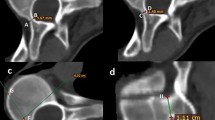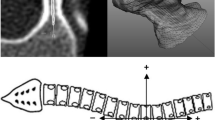Abstract
Purpose
The dimensions of the thoracic intervertebral foramen in adolescent idiopathic scoliosis (AIS) have not previously been quantified. Better understanding of the dimensions of the foramen may be useful in surgical planning. This study describes a reproducible method for measurement of the thoracic foramen in AIS using computed tomography (CT).
Methods
In 23 preoperative female patients with Lenke 1 type AIS with right-side convexity major curves confined to the thoracic spine the foraminal height (FH), foraminal width (FW), pedicle to superior articular process distance (P-SAP), and cross-sectional foraminal area (FA) were measured using multiplanar reconstructed CT. Measurements were made at entrance, midpoint, and exit of the thoracic foramina from T1–T2 to T11–T12. Results were also correlated with dependent variables of major curve Cobb angle measured on X-ray and CT, age, weight, Lenke classification subtype, Risser grade, and number of spinal levels in the major curve.
Results
The FH, FW, P-SAP, and FA dimensions and ratios are all significantly larger on the convexity of the major curve and maximal at or close to the apex. Mean thoracic foraminal dimensions change in a predictable manner relative to position on the major thoracic curve. There was no statistically significant correlation with the measured foraminal dimensions or ratios and the individual dependent variables. The average ratio of convexity to concavity dimensions at the apex foramina for entrance, midpoint, and exit, respectively, are FH (1.50, 1.38, 1.25), FW (1.28, 1.30, 0.98), FA (2.06, 1.84, 1.32), and P-SAP (1.61, 1.47, 1.30).
Conclusion
Foraminal dimensions of the thoracic spine are significantly affected by AIS. Foraminal dimensions have a predictable convexity-to-concavity ratio relative to the proximity to the major curve apex. Surgeons should be aware of these anatomical differences during scoliosis correction surgery.
Similar content being viewed by others
References
Hefti F. Pathogenesis and biomechanics of adolescent idiopathic scoliosis (AIS). J Child Orthop 2013;7:17–24.
Parent S, Labelle H, Skalli W, et al. Morphometric analysis of anatomic scoliotic specimens. Spine (Phila Pa 1976) 2002;27:2305–11.
Parent S, Labelle H, Skalli W, de Guise J. Thoracic pedicle morphometry in vertebrae from scoliotic spines. Spine (Phila Pa 1976) 2004;29:239–48.
Sarwahi V, Sugarman EP, Wollowick AL, et al. Prevalence, distribution, and surgical relevance of idiopathic scoliosis vs. no deformity. J Bone Joint Surg 2014;92:1–8.
Cinotti G, De Santis P, Nofroni I, Postacchini F. Stenosis of lumbar intervertebral foramen. Spine (Phila Pa 1976) 2002;27:223–9.
Panjabi M, Duranceau J, Goel V. Cervical human vertebrae quantitative three-dimensional anatomy of the middle and lower regions. Spine (Phila Pa 1976) 1991;16:861–9.
Panjabi M, Takata K, Goel V. Thoracic human vertebrae quantitative three-dimensional anatomy. Spine (Phila Pa 1976) 1991;16:888–901.
Panjabi M, Goel V, Oxland T. Human lumbar vertebrae: quantitative three-dimensional anatomy. Spine (Phila Pa 1976) 1992;17:299–306.
Panjabi MM, O’Holleran JD, Crisco JJ, Kothe R. Complexity of the thoracic spine pedicle anatomy. Eur Spine J 1997;6:19–24.
Liljenqvist UR, Link TM, Halm HF. Morphometric analysis of thoracic and lumbar vertebrae in idiopathic scoliosis. Spine (Phila Pa 1976) 2000;25:1247–53.
Makino T, Kaito T, Fujiwara H, Yonenobu K. Morphometric analysis using multiplanar reconstructed CT of the lumbar pedicle in patients with degenerative lumbar scoliosis characterized by a Cobb angle of 30° or greater. J Neurosurg Spine 2012;17:256–62.
Ploumis A, Transfeldt EE, Gilbert TJ, et al. Degenerative lumbar scoliosis: radiographic correlation of lateral rotatory olisthesis with neural canal dimensions. Spine (Phila Pa 1976) 2006;31:2353–8.
Ebraheim NA, Liu J, Shafiq Q, et al. Quantitative analysis of changes in cervical intervertebral foramen size with vertebral translation. Spine (Phila Pa 1976) 2006;31:E62–5.
Evangelopoulos D. Computerized tomographic morphometric analysis of the cervical spine. Open Orthop J 2012;6:250–4.
Kaneko Y, Matsumoto M, Takaishi H, et al. Morphometric analysis of the lumbar intervertebral foramen in patients with degenerative lumbar scoliosis by multidetector-row computed tomography. Eur Spine J 2012;21:2594–602.
Fujiwara A, An HS, Lim TH, Haughton VM. Morphologic changes in the lumbar intervertebral foramen due to flexion-extension, lateral bending, and axial rotation: an in vitro anatomic and biomechanical study. Spine (Phila Pa 1976) 2001;26:876–82.
Inufusa A, An H, Lim T, Hasegawa T. Anatomic changes of the spinal canal and intervertebral foramen associated with flexion-extension movement. Spine (Phila Pa 1976) 1996;21:2412–20.
Yuan C, Zhu H, Song D, et al. Impact and clinical significance of pedicle length on spinal canal and intervertebral foramen area. Int J Clin Exp Med 2014;7:163–9.
Osman S, Nibu K, Panjabi M. Transforaminal and posterior decompressions of the lumbar spine: a comparative study of stability and intervertebral foramen area. Spine (Phila Pa 1976) 1997;22:1690–5.
Smith G, Aspden R, Porter R. Measurement of vertebral foraminal dimensions using three-dimensional computerized tomography. Spine (Phila Pa 1976) 1993;18:629–36.
Vrtovec T, Pernus F, Likar B. A review of methods for quantitative evaluation of axial vertebral rotation. Eur Spine J 2009;18:1079–90.
Vrtovec T, Pernus F, Likar B. A review of methods for quantitative evaluation of spinal curvature. Eur Spine J 2009;18:593–607.
Krag M, Weaver D, Beynnon B, Haugh L. Morphometry of the thoracic and lumbar spine related to transpedicular screw placement for surgical spinal fixation. Spine (Phila Pa 1976) 1988;13:27–32.
Misenhimer G, Peek R, Wiltse L. Anatomic analysis of pedicle cortical and cancellous diameter as related to screw size. Spine (Phila Pa 1976) 1989;14:367–72.
Xiong B, Sevastik B, Sevastik J, et al. Horizontal plane morphometry of normal and scoliotic vertebrae—a methodological study. Eur Spine J 1995;4:6–10.
Bland JM, Altman DG. Applying the right statistics: analyses of measurement studies. Ultrasound Obstet Gynecol 2003;22:85–93.
Lee WT, Cheung CS, Tse YK, et al. Association of osteopenia with curve severity in adolescent idiopathic scoliosis: a study of 919 girls. Osteoporos Int 2005;12:1924–32.
Hicks JM, Singla A, Shen FH, Arlet V. Complications of pedicle screw fixation in scoliosis surgery: a systematic review. Spine (Phila Pa 1976) 2010;35:E465–70.
Modi HN, Suh SW, Fernandez H, et al. Accuracy and safety of pedicle screw placement in neuromuscular scoliosis with free-hand technique. Eur Spine J 2008;17:1686–96.
Modi H, Suh SW, Song HR, Yang JH. Accuracy of thoracic pedicle screw placement in scoliosis using the ideal pedicle entry point during the freehand technique. Int Orthop 2009;33:469–75.
Sarlak AY, Tosun B, Atmaca H, et al. Evaluation of thoracic pedicle screw placement in adolescent idiopathic scoliosis. Eur Spine J 2009;18:1892–7.
Kuklo TR, Lenke LG, O’Brien MF, et al. Accuracy and efficacy of thoracic pedicle screws in curves more than 90 degrees. Spine (Phila Pa 1976) 2005;30:222–6.
Samdani AF, Ranade A, Sciubba DM, et al. Accuracy of free-hand placement of thoracic pedicle screws in adolescent idiopathic scoliosis: How much of a difference does surgeon experience make? Eur Spine J 2010;19:91–5.
Di Silvestre M, Parisini P, Lolli F, Bakaloudis G. Complications of thoracic pedicle screws in scoliosis treatment. Spine (Phila Pa 1976) 2007;32:1655–61.
Suk SI, Kim WJ, Lee SM, et al. Thoracic pedicle screw fixation in spinal deformities: are they really safe? Spine (Phila Pa 1976) 2001;26:2049–57.
Author information
Authors and Affiliations
Corresponding author
Additional information
Author disclosures
TJLW (none); MTI (travel allowances to institution from NuVasive; research support salary from Medtronic); RDL (received payment for speaking and/or teaching arrangements from Medtronic; research support salaries to institution from Synthes and Medtronic; grants to institution from DePuy Synthes in negotiation; fellowship support to institution from DePuy Synthes); GNA (received payment for speaking and/or teaching arrangements from Medtronic; research support salaries to institution from Synthes and Medtronic; grants to institution from DePuy Synthes in negotiation, all outside of submitted work); MJP (owns stock in Tissue Therapies; travel allowances to institution from NuVasive; holds scientific advisory board or other office from Therapeutics Goods Administration, Australia); CJA (travel allowances to institution from NuVasive; research support salaries and materials to institution from Synthes and Medtronic; grants to institution from DePuy Synthes in negotiation; fellowship support from European Union Fellowship FP7-PEOPLE-2010-IIF-274964 salary 2012–13, all outside of submitted work).
No funds were received in support of this work. No benefits in any form have been or will be received from a commercial party related directly or indirectly to the subject of this manuscript.
Rights and permissions
About this article
Cite this article
Loch-Wilkinson, T.J., Izatt, M.T., Labrom, R.D. et al. Morphometric Analysis of the Thoracic Intervertebral Foramen Osseous Anatomy in Adolescent Idiopathic Scoliosis Using Low-Dose Computed Tomography. Spine Deform 4, 182–192 (2016). https://doi.org/10.1016/j.jspd.2015.10.004
Received:
Revised:
Accepted:
Published:
Issue Date:
DOI: https://doi.org/10.1016/j.jspd.2015.10.004




